Let’s be honest – being a marketer in the digital era can be equally exciting, as nerve-wracking.
It brings to mind the Paul McCartney classic – you either “win or lose” or “sink or swim”.
On the one hand, with thousands of clients and leads just a couple of swipes and clicks away, advertising and collecting feedback has never been so easy.
On the other, for the very same reason, it’s also become horrendously challenging to keep track of everything that goes on once our offer is out in the open.
If you’re missing out on positive opinions, it’s a pity you’re not using them for brand endorsements (and a motivation boost, for that matter).
But it’s a full-fledged tragedy if you’re not aware of (and where) your clients are leaving you negative feedback, and can’t make amends or drive your product strategy accordingly.

In the following post, we’ll discuss:
- What type of customer feedback you should be looking out for (hint: it’s not just survey responses and opinions!),
- The feedback channels you should be paying attention to,
- How to instate a sustainable customer feedback management procedure, and which customer feedback tools and tricks you can use.
So, let’s talk about effective customer feedback management. And I’m thinking “level: Jedi master” here.
What is customer feedback management and why do you need it?
Customer feedback management is all about collecting, analyzing, and acting on customer opinions to improve your products, services, and overall customer experience. In simple terms, it helps you understand what your customers love, what frustrates them, and what they wish you’d do better.
Customer feedback management isn’t just a nice-to-have—it’s a game changer. Without it, you’re flying blind, making decisions based on guesswork instead of real customer insights.
One of the biggest perks? Catching problems early. Negative reviews and complaints can snowball fast, but a good feedback system helps you spot issues before they turn into major headaches. And when customers see that you’re actually listening and making changes based on their input, they feel valued—meaning they’re way more likely to stick around.
It’s also a goldmine for new ideas. Some of the best product improvements come straight from customer suggestions. Instead of guessing what people want, you get a direct line to what actually matters to them.
Ignoring feedback is a risky move because your competitors are probably paying attention. Businesses that take customer opinions seriously tend to outshine those that don’t. Plus, when you actively listen and respond, you build trust, boost your reputation, and encourage positive word-of-mouth.
At the end of the day, feedback isn’t just something you collect—it’s something you act on. And when done right, it can turn casual buyers into lifelong fans.
Types of Customer Feedback
Before we talk about how to manage customer feedback, let’s take a look at the different types of feedback you can collect and their manin benefits.
1. Direct feedback (you ask, they answer)
This includes surveys, interviews, and focus groups—any method where you directly ask customers what they think. The best part? You control the questions and get specific answers.
Survicate, a powerful feedback tool, makes this process seamless with targeted surveys that collect insights in real time. Whether it's a quick pop-up survey on your website or a follow-up email, Survicate helps you get structured responses that actually guide decisions.

2. Indirect feedback (customers talk, you listen)
Not all feedback comes from surveys. Customers share their opinions on social media, review sites, and even through product usage data. Monitoring these channels gives you unfiltered insights into what people really think about your brand—both the good and the bad.
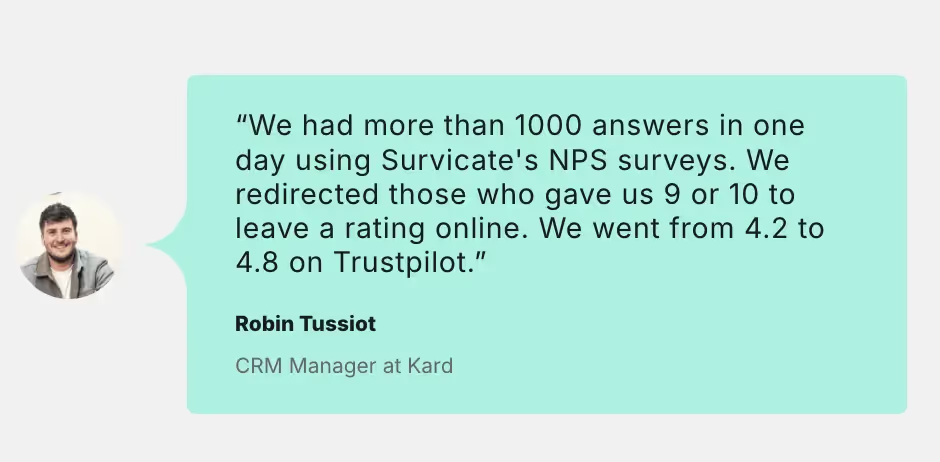
Survicate pulls feedback from all sources—website surveys, email responses, social media, app store reviews, live chats, and even customer support tickets. Instead of hopping between platforms, you get a single, organized view of customer topics and sentiment in our Insights Hub, making it easier to track trends and react fast.
As a result, you’ll always know what your customers are saying—whether they leave a glowing review or flag a critical issue–and be able to identify the scale of a specific topic with ease and zero manual work.

3. Quantitative feedback (the numbers game)
This is all about measurable data—ratings, Net Promoter Score (NPS), and customer satisfaction (CSAT) scores. If you need quick insights into overall trends (like how happy customers are on a scale of 1-10), this is your go-to.
Survicate shines here, too, with built-in analytics that turn raw data into visual reports, making it easy to track progress and spot trends:
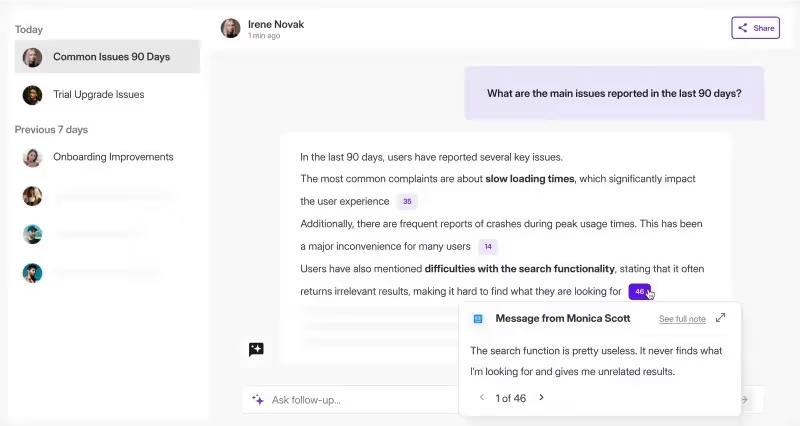
4. Qualitative feedback (the why behind the numbers)
Sometimes, numbers aren’t enough—you need context. Comments, suggestions, detailed customer narratives, or other types of qualitative feedback, help explain why someone rated your service high or low. Open-ended responses can reveal pain points, unexpected problems, or even great new ideas.
What is the customer feedback loop
Have you ever read about customer feedback loop?
If you haven’t, it represents the way you derive and effectively process customer feedback, so:
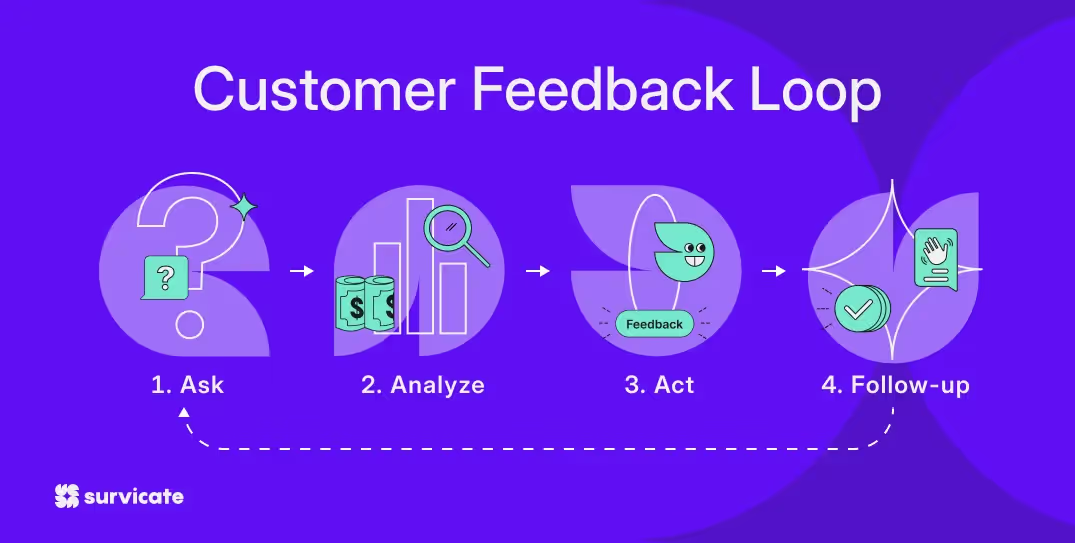
Let’s take surveys as an example.
You ask a question, segment respondents, responses and/or questions into groups, create an action plan based on your findings, and follow-up.
So far, so good.
Now, here’s the catch:
You won’t make the most out of steps #3 and #4 if you don’t cross-analyze your survey findings with external feedback.
The point being: If there’s anything better than mastering survey design, it’s mastering and boosting their effectiveness through an understanding of where they stand in the entire feedback ecosystem.
Now, before we proceed to external feedback channels, let’s take a look at the types of feedback you should be reviewed on a daily basis.
Customer Feedback Channels
Emails: They say email is still king, and it’s hard not to agree. A lot of online stores don’t offer live chat, and even if they do, chances are customer topics such as official complaints will still be moved to the more formal channel.
It’s the most universal communication method, and should definitely be on top of your watchlist!
Surveys: No other feedback collection method will help you build trust and customer satisfaction quite like this one (you can test out two of our most popular customer satisfaction survey templates yourself here– NPS surveys and CSAT survey).
Surveys are also unbeatable when it comes to analyzing your responses – you can quantify the answers from closed-ended questions in a built-in analytics tool like our own, or via Google Sheets/Excel. Think – a matter of seconds.
Communication tools: These are becoming more common by the day, especially among SaaS companies. For instance, at Survicate, we offer live chat communication via Intercom to all our users. Simply put, it’s the fastest way to communicate with customer success.
Pro tip: if you’re an Intercom user like ourselves, you should also make extensive use of tags. It’ll help you maximize your feedback management tricks).

Interviews: Regardless if it’s video conferences or live meetings, interviews tend to revolutionize what you previously thought about your company and how it serves its users. Plus, if you use a transcription tool, you can also analyze insights from recordings.
App stores: If you’re an app developer, it’s absolutely crucial that you make sure any negative ratings and opinions are responded to and processed to drive product roadmap. If not, you can easily end up being ‘buried’ in app store results’ lists as unreliable software.
Online opinion sites: Similarly to app stores, some leads will only trust your user opinions/ratings, if they’re on independent sites. Depending on what your product is, these can be e-commerce stores like Amazon, or comparative sites.
Social media: The big start of the past (and current) decade. If you’re not evaluated highly on these outlets, or at least don’t officially respond to criticism, then you’re likely looking towards souring churn rates and a decrease in signups.
Last, but not least, let’s take a look at the tools and methods you can use to make your marketer’s FOMO a distant memory.
Types of customer feedback management tools
Customer feedback management tools come in several forms, each serving different needs depending on how businesses collect and act on feedback.
One of the most common types is survey-based tools. These help businesses gather structured input from customers through forms or standardized metrics like Net Promoter Score (NPS) or Customer Satisfaction (CSAT). They're ideal for capturing general sentiment or gauging satisfaction after specific interactions.
This category also includes in-app or website feedback surveys. These allow users to submit feedback directly within a product or website, often triggered by certain actions or usage patterns. They are especially effective for digital products, where immediate, contextual insights can inform design or feature improvements.
Customer service platforms also serve as feedback channels by collecting input during or after support interactions. These tools can highlight customer pain points in service workflows or product-related issues that surface during support exchanges.
Similarly, social listening tools track brand mentions and customer opinions across social media, forums, and public platforms. This type of tool is useful for understanding broader sentiment, identifying trending issues, or responding to public feedback.
Some businesses also use review aggregation systems to consolidate and monitor customer reviews from various public sources. These tools are especially relevant for industries where public perception heavily influences buying decisions, such as hospitality or retail.
Then there are more comprehensive platforms often referred to as voice-of-the-customer (VoC) solutions, such as Survicate. These systems combine multiple feedback channels—surveys, support, social listening, and more—into a unified framework. They typically offer advanced analytics and are suited for companies looking to tie feedback directly to strategy or customer experience initiatives.
Lastly, community-driven platforms allow customers to submit ideas, suggestions, or complaints, often in a shared space where others can upvote or comment. This type of system helps surface the most requested features or concerns and is commonly used in product development and innovation cycles.

So, you already know it can do a few impressive tricks when it comes to integrating with your communicator tools and tagging customer feedback.
What else is on the table? Or, maybe even more specifically, what should a comprehensive, 360-degree feedback management tool offer?
According to a Forrester report, there are 4 main activities you should be able to perform through a customer feedback management tool to make sure it aligns with Voice of the Customer programs:
Listening: What are my customers saying about me on all channels?
Interpreting: Making sense of the information collected while listening.
Acting: Based on insights gleaned during interpretation, prescribing and deploying appropriate actions through resolution.
Monitoring: How am I doing? What is my customer satisfaction score? Are the actions I am taking result in loyal customers?
Survicate ticks all the boxes ✅
How Survicate can help you manage customer feedback
Survicate makes managing customer feedback not only easier but far more insightful—especially with the addition of the Insights Hub and its built-in AI-powered Research Assistant. These tools go beyond traditional survey analysis, helping teams truly understand what customers are saying, where the biggest pain points lie, and what to prioritize next.
One place for all your feedback
With Insights Hub, Survicate centralizes feedback from all your channels—surveys, support tickets, app store reviews, emails, live chats, and more—into one platform. No more hopping between tools or chasing siloed insights across departments. Once connected, all feedback flows in automatically, saving you hours of manual work and ensuring nothing gets missed.
Smart categorization and organization
Rather than sorting through feedback manually, Survicate uses AI-driven categorization to automatically group responses into Topics and surface relevant Insights. Whether it’s feature requests, usability issues, or praise for recent updates, everything is sorted so your team can see patterns and trends at a glance. You can even pin, edit, or resolve Insights, making it easy to manage follow-ups or track improvements over time.
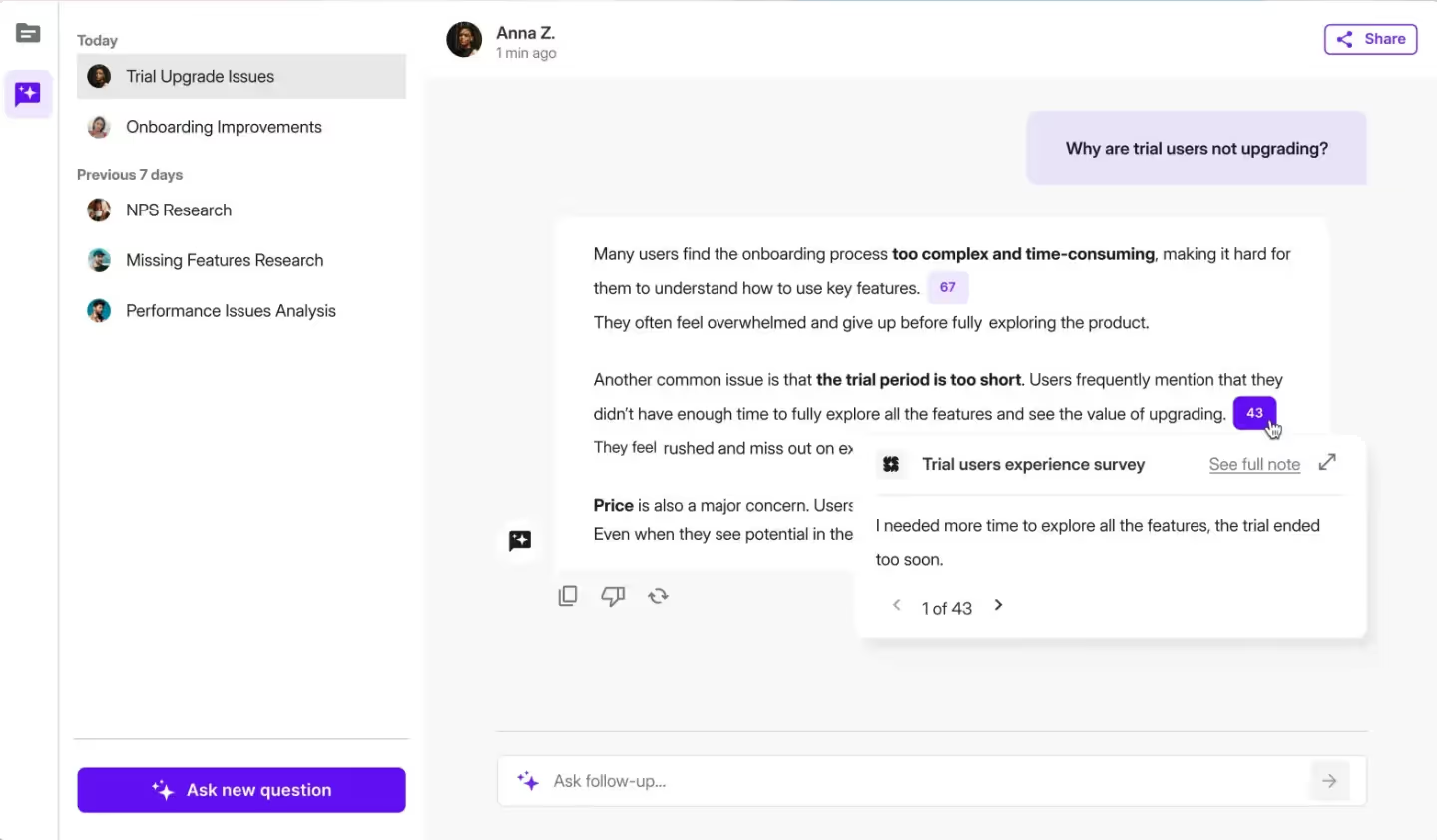
Instant insights with Research Assistant
Need quick answers from your data? Ask the Research Assistant. This AI tool scans through all your connected feedback and survey results to generate clear, actionable responses. For example, you can ask:
- “What are users saying about our onboarding experience?”
- “Which features are most requested this quarter?”
- “Why are users canceling their subscriptions?”
The Assistant provides not just summaries, but also references specific feedback sources, so your conclusions are backed by real customer input—not guesswork.
Survicate isn’t just a survey tool. It’s your customer feedback command center. Ready to give it a try? Sign up for a 10-day free trial and discover the powerful features that will make managing customer feedback a breeze.








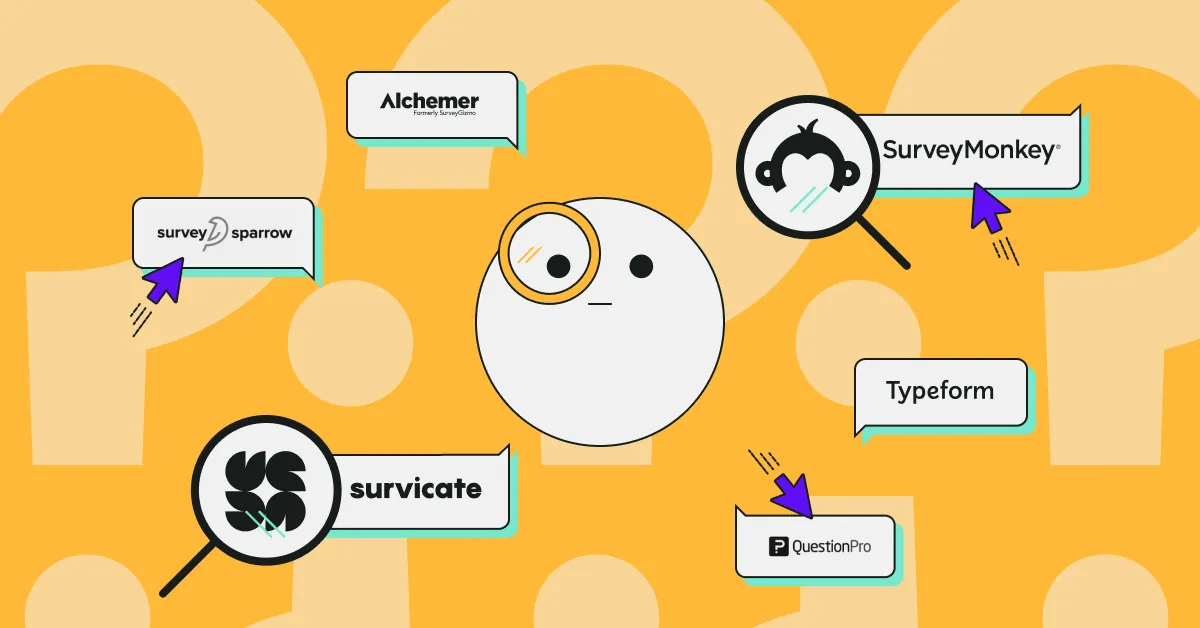


.png)



.svg)

.svg)



